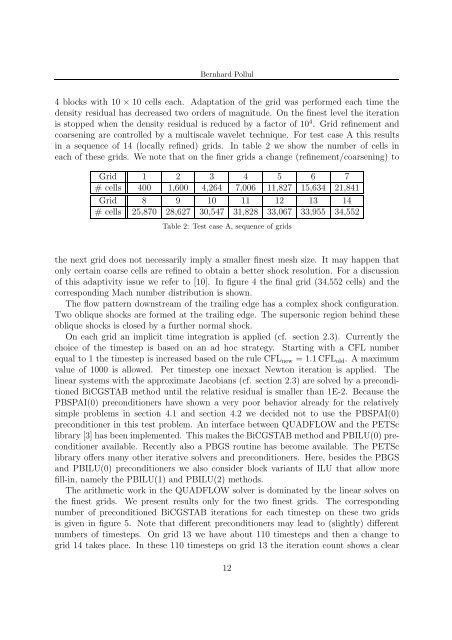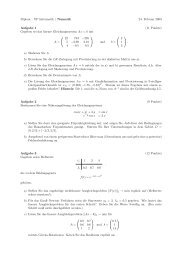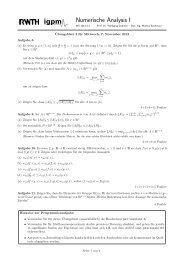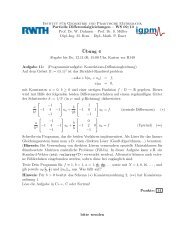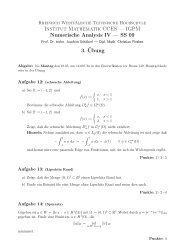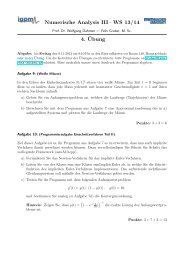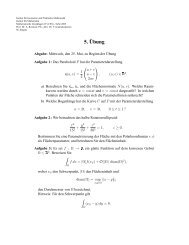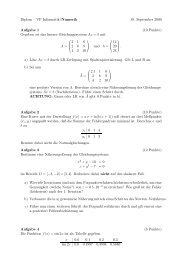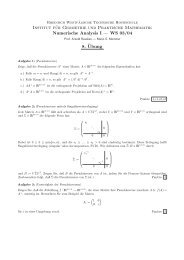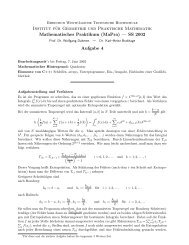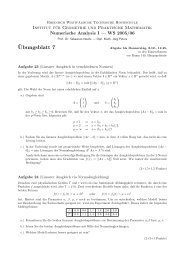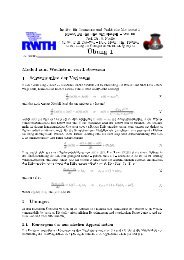preconditioners for linearized discrete compressible euler equations
preconditioners for linearized discrete compressible euler equations
preconditioners for linearized discrete compressible euler equations
Create successful ePaper yourself
Turn your PDF publications into a flip-book with our unique Google optimized e-Paper software.
Bernhard Pollul<br />
4 blocks with 10 × 10 cells each. Adaptation of the grid was per<strong>for</strong>med each time the<br />
density residual has decreased two orders of magnitude. On the finest level the iteration<br />
is stopped when the density residual is reduced by a factor of 10 4 . Grid refinement and<br />
coarsening are controlled by a multiscale wavelet technique. For test case A this results<br />
in a sequence of 14 (locally refined) grids. In table 2 we show the number of cells in<br />
each of these grids. We note that on the finer grids a change (refinement/coarsening) to<br />
Grid 1 2 3 4 5 6 7<br />
# cells 400 1,600 4,264 7,006 11,827 15,634 21,841<br />
Grid 8 9 10 11 12 13 14<br />
# cells 25,870 28,627 30,547 31,828 33,067 33,955 34,552<br />
Table 2: Test case A, sequence of grids<br />
the next grid does not necessarily imply a smaller finest mesh size. It may happen that<br />
only certain coarse cells are refined to obtain a better shock resolution. For a discussion<br />
of this adaptivity issue we refer to [10]. In figure 4 the final grid (34,552 cells) and the<br />
corresponding Mach number distribution is shown.<br />
The flow pattern downstream of the trailing edge has a complex shock configuration.<br />
Two oblique shocks are <strong>for</strong>med at the trailing edge. The supersonic region behind these<br />
oblique shocks is closed by a further normal shock.<br />
On each grid an implicit time integration is applied (cf. section 2.3). Currently the<br />
choice of the timestep is based on an ad hoc strategy. Starting with a CFL number<br />
equal to 1 the timestep is increased based on the rule CFL new = 1.1 CFL old . A maximum<br />
value of 1000 is allowed. Per timestep one inexact Newton iteration is applied. The<br />
linear systems with the approximate Jacobians (cf. section 2.3) are solved by a preconditioned<br />
BiCGSTAB method until the relative residual is smaller than 1E-2. Because the<br />
PBSPAI(0) <strong>preconditioners</strong> have shown a very poor behavior already <strong>for</strong> the relatively<br />
simple problems in section 4.1 and section 4.2 we decided not to use the PBSPAI(0)<br />
preconditioner in this test problem. An interface between QUADFLOW and the PETSc<br />
library [3] has been implemented. This makes the BiCGSTAB method and PBILU(0) preconditioner<br />
available. Recently also a PBGS routine has become available. The PETSc<br />
library offers many other iterative solvers and <strong>preconditioners</strong>. Here, besides the PBGS<br />
and PBILU(0) <strong>preconditioners</strong> we also consider block variants of ILU that allow more<br />
fill-in, namely the PBILU(1) and PBILU(2) methods.<br />
The arithmetic work in the QUADFLOW solver is dominated by the linear solves on<br />
the finest grids. We present results only <strong>for</strong> the two finest grids. The corresponding<br />
number of preconditioned BiCGSTAB iterations <strong>for</strong> each timestep on these two grids<br />
is given in figure 5. Note that different <strong>preconditioners</strong> may lead to (slightly) different<br />
numbers of timesteps. On grid 13 we have about 110 timesteps and then a change to<br />
grid 14 takes place. In these 110 timesteps on grid 13 the iteration count shows a clear<br />
12


